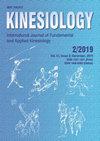Kinematics of Usain Bolt’s maximal sprint velocity
IF 0.9
4区 医学
Q4 REHABILITATION
引用次数: 11
Abstract
This study investigated the maximal sprint velocity kinematics of the fastest 100 m sprinter, Usain Bolt. Two high-speed video cameras recorded kinematics from 60 to 90 m during the men 100 m final at the World Challenge in Zagreb, Croatia. Despite a relatively slow reaction time (194 ms), Bolt won in 9.85 s (mean velocity: 10.15 m/s). His fastest 20-m section velocity was 12.14 m/s, reached between 70 to 90 m, and used a 2.70-m long stride and 4.36 strides/s frequency. At maximal velocity, his contact and flight times were 86 and 145 ms, and vertical ground reaction force equal to 4.2 times body weight (3932 N). The braking and propulsion phase represented 37 and 63% of ground contact, with his centre of mass exhibiting minor reductions in horizontal velocity (2.7%) and minimal vertical displacement (4.9 cm). Bolt's maximal sprint velocity and international dominance stem from advantageous anthropometrical characteristics, coordinated motor abilities, power generation capacities, and effective technique. This study confirms that his maximal velocity is achieved using a relatively long stride, minimal braking phase, high vertical ground reaction force, and minimal vertical displacement. This study is the first in-depth biomechanical analysis with segmental reconstruction of Bolt's maximal sprinting velocity.Keywords: 100 m sprint; athletics; biomechanics; sport performance; sprint running尤塞恩·博尔特最大冲刺速度的运动学
本研究调查了最快的100米短跑运动员尤塞恩·博尔特的最大冲刺速度运动学。在克罗地亚萨格勒布举行的世界挑战赛男子100米决赛中,两台高速摄像机记录了从60米到90米的运动学。尽管反应时间相对较慢(194毫秒),博尔特还是以9.85秒(平均速度:10.15米/秒)的成绩获胜。他最快的20米区间速度为12.14米/秒,达到70至90米,步幅为2.70米,步频为4.36步/秒。在最大速度下,他的接触和飞行时间分别为86和145毫秒,垂直地面反作用力等于4.2倍体重(3932牛顿)。制动和推进阶段分别占地面接触的37%和63%,质心的水平速度(2.7%)和最小垂直位移(4.9厘米)略有下降。博尔特的最大冲刺速度和国际领先地位源于其优越的人体测量特征、协调的运动能力、发电能力和有效的技术。这项研究证实,他的最大速度是通过相对较长的步幅、最小的制动阶段、较高的垂直地面反作用力和最小的垂直位移来实现的。本研究首次对博尔特的最大冲刺速度进行节段重建,进行了深入的生物力学分析。关键词:100米短跑;体育生物力学;运动表现;短跑
本文章由计算机程序翻译,如有差异,请以英文原文为准。
求助全文
约1分钟内获得全文
求助全文
来源期刊

Kinesiology
REHABILITATION-SPORT SCIENCES
CiteScore
1.90
自引率
8.30%
发文量
16
审稿时长
>12 weeks
期刊介绍:
Kinesiology – International Journal of Fundamental and Applied Kinesiology (print ISSN 1331- 1441, online ISSN 1848-638X) publishes twice a year scientific papers and other written material from kinesiology (a scientific discipline which investigates art and science of human movement; in the meaning and scope close to the idiom “sport sciences”) and other adjacent human sciences focused on sport and exercise, primarily from anthropology (biological and cultural alike), medicine, sociology, psychology, natural sciences and mathematics applied to sport in its broadest sense, history, and others. Contributions of high scientific interest, including also results of theoretical analyses and their practical application in physical education, sport, physical recreation and kinesitherapy, are accepted for publication. The following sections define the scope of the journal: Sport and sports activities, Physical education, Recreation/leisure, Kinesiological anthropology, Training methods, Biology of sport and exercise, Sports medicine and physiology of sport, Biomechanics, History of sport and Book reviews with news.
 求助内容:
求助内容: 应助结果提醒方式:
应助结果提醒方式:


